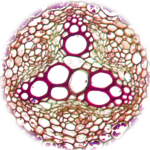Plant Survey Slide Set SET B-1 SURVEY OF THE PLANT KINGDOM, 25 SLIDES
$142.00
SURVEY OF THE PLANT KINGDOM, 25 SLIDES
Plant Survey Slide Set
SET B-1
SURVEY OF THE PLANT KINGDOM, 25 SLIDES
1) 2-2 “GLOEOCAPSA; COLONIAL SPHERICAL CELLS FORMING INDIVIDUAL GELATINOUS ENVELOPES WITHIN THE COMMON ENVELOPE OF THE MOTHER CELL, WM.”
2) 2-8 “OSCILLATORIA; FILAMENTS APPARENTLY WITHOUT SHEATHS, WM.”
3) 2-16 “CHLAMYDOMONAS; VEGETATIVE & VEGETATIVE REPRODUCTIVE FORMS, WM.”
4) 2-20 “DIATOMS; MIXED FRESH WATER SPECIES, PROTOPLASTS STAINED, WM.”
5) 2-24B OEDOGONIUM; WM. (13-2)
6) 2-30B “SPIROGYRA; LARGE SPECIES WITH MULTIPLE CHLOROPLASTS DEMONSTRATING SCALARIFORM CONJUGATION & VEGETATIVE FILAMENTS, WM.”
7) 2-36A “VOLVOX; COLONIES WITH VEGETATIVE & SEXUAL STAGES, WM.”
8) 3-66A “PUCCINIA GRAMINIS (WHEAT RUST); UREDINIA ON TRITICUM LEAF OR STEM, SECTION.”
9) 4-2C “RHIZOPUS STOLONIFER; SPORANGIA & ZYGOTES ON THE SAME SLIDE, WM.”
10) 4-10A “PENICILLIUM; MYCELIUM WITH CONIDIOPHORES, WM.”
11) 4-12 “PEZIZA (OR RELATED GENUS); CUP WITH ASCI, LS.”
12) 4-16A “COPRINUS (MUSHROOM); ENTIRE PILEUS, CS.”
13) 4-102SP “BACTERIA, 3 TYPES; WM, SEPARATE SMEARS, ROUTINE STAIN.”
14) 5-6NNN “MARCHANTIA POLYMORPHA; SPOROPHYTES, LS FOR GENERAL STRUCTURE.”
15) 6-4H MOSS PROTONEMA; WM. (14-1)
16) 7-14A FERN STEM (RHIZOME); CS. (14-2)
17) 7-16E FERN GAMETOPHYTE; WM. (4.3)
18) 10-6E “PINUS; LEAF, CS, TWO-NEEDLE TYPE.”
19) 11-32D “TILIA AMERICANA (BASSWOOD, TILIACEAE); THREE YEAR STEM, CS.”
CS = Cross Section: So the slide shows a thin section through the transverse plane of an organism.
LS = Longitudinal Section: So the slide shows a vertical section of the organism along the longest plane.
WM = Whole Mount: So the slide shows an entire organism or structure, as indicated, is preserved on the slide
CRT = Cross Section, Radial Section, and Tangential Section: So the slide shows sections of wood along the transverse, radial, and tangential planes.
Sag = Sagittal Section: So the slide shows a thin section through the sagittal plane through the midline.
Serial Sections = So the slide shows consecutive sections of the organism.
Rep = Representative Sections (Embryology): So the slide shows one section of the organism from each typical area of study.
 Triarch Incorporated’s name is based on a botanical slide
Triarch Incorporated’s name is based on a botanical slide
that illustrates three ridges of xylem found in the vascular cylinder of the Ranunculus root.
Our founder, George H. Conant, Ph.D., had three principles in mind:
Accuracy, Service, and Dependability.
He incorporated these into the Triarch logo based on the triarch vascular cylinder.

